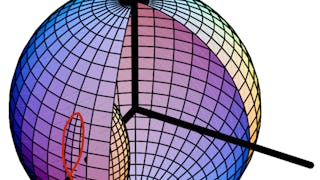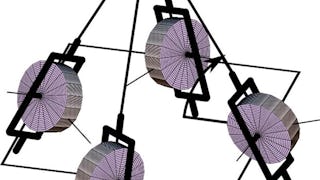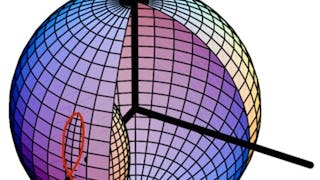The movement of bodies in space (like spacecraft, satellites, and space stations) must be predicted and controlled with precision in order to ensure safety and efficacy. Kinematics is a field that develops descriptions and predictions of the motion of these bodies in 3D space. This course in Kinematics covers four major topic areas: an introduction to particle kinematics, a deep dive into rigid body kinematics in two parts (starting with classic descriptions of motion using the directional cosine matrix and Euler angles, and concluding with a review of modern descriptors like quaternions and Classical and Modified Rodrigues parameters). The course ends with a look at static attitude determination, using modern algorithms to predict and execute relative orientations of bodies in space.

Gain next-level skills with Coursera Plus for $199 (regularly $399). Save now.

Kinematics: Describing the Motions of Spacecraft
This course is part of Spacecraft Dynamics and Control Specialization

Instructor: Hanspeter Schaub
27,104 already enrolled
Included with
(340 reviews)
What you'll learn
Differentiate a vector as seen by another rotating frame and derive frame dependent velocity and acceleration vectors
Apply the Transport Theorem to solve kinematic particle problems and translate between various sets of attitude descriptions
Add and subtract relative attitude descriptions and integrate those descriptions numerically to predict orientations over time
Derive the fundamental attitude coordinate properties of rigid bodies and determine attitude from a series of heading measurements
Skills you'll gain
Details to know

Add to your LinkedIn profile
See how employees at top companies are mastering in-demand skills

Build your subject-matter expertise
- Learn new concepts from industry experts
- Gain a foundational understanding of a subject or tool
- Develop job-relevant skills with hands-on projects
- Earn a shareable career certificate

There are 4 modules in this course
This module covers particle kinematics. A special emphasis is placed on a frame-independent vectorial notation. The position velocity and acceleration of particles are derived using rotating frames utilizing the transport theorem.
What's included
13 videos3 assignments
This module provides an overview of orientation descriptions of rigid bodies. The 3D heading is here described using either the direction cosine matrix (DCM) or the Euler angle sets. For each set the fundamental attitude addition and subtracts are discussed, as well as the differential kinematic equation which relates coordinate rates to the body angular velocity vector.
What's included
18 videos1 reading10 assignments
This module covers modern attitude coordinate sets including Euler Parameters (quaternions), principal rotation parameters, Classical Rodrigues parameters, modified Rodrigues parameters, as well as stereographic orientation parameters. For each set the concepts of attitude addition and subtraction is developed, as well as mappings to other coordinate sets.
What's included
29 videos18 assignments
This module covers how to take an instantaneous set of observations (sun heading, magnetic field direction, star direction, etc.) and compute a corresponding 3D attitude measure. The attitude determination methods covered include the TRIAD method, Devenport's q-method, QUEST as well as OLAE. The benefits and computation challenges are reviewed for each algorithm.
What's included
13 videos5 assignments1 peer review
Earn a career certificate
Add this credential to your LinkedIn profile, resume, or CV. Share it on social media and in your performance review.
Instructor

Offered by
Explore more from Physics and Astronomy
 Status: Free Trial
Status: Free TrialUniversity of Colorado Boulder
 Status: Free Trial
Status: Free TrialUniversity of Colorado Boulder
 Status: Free Trial
Status: Free TrialUniversity of Colorado Boulder
 Status: Free Trial
Status: Free TrialUniversity of Colorado Boulder
Why people choose Coursera for their career




Learner reviews
340 reviews
- 5 stars
90.88%
- 4 stars
6.76%
- 3 stars
0.88%
- 2 stars
0.88%
- 1 star
0.58%
Showing 3 of 340
Reviewed on Oct 18, 2017
Brilliant classes! Absolutely brilliant, enjoyed every bit of it. All you need is that you should love Physics and Maths to attend these classes. If you do, it is an enriching experience for you.
Reviewed on Aug 11, 2020
Lectures are great and professor method of teaching is superb i would highly recommend this course for space enthusiasts
Reviewed on Sep 12, 2020
Best technical course on coursera. Instructor is full of knowledge and is one of the best teachers i have came across.
Frequently asked questions
To access the course materials, assignments and to earn a Certificate, you will need to purchase the Certificate experience when you enroll in a course. You can try a Free Trial instead, or apply for Financial Aid. The course may offer 'Full Course, No Certificate' instead. This option lets you see all course materials, submit required assessments, and get a final grade. This also means that you will not be able to purchase a Certificate experience.
When you enroll in the course, you get access to all of the courses in the Specialization, and you earn a certificate when you complete the work. Your electronic Certificate will be added to your Accomplishments page - from there, you can print your Certificate or add it to your LinkedIn profile.
Yes. In select learning programs, you can apply for financial aid or a scholarship if you can’t afford the enrollment fee. If fin aid or scholarship is available for your learning program selection, you’ll find a link to apply on the description page.
More questions
Financial aid available,
¹ Some assignments in this course are AI-graded. For these assignments, your data will be used in accordance with Coursera's Privacy Notice.





